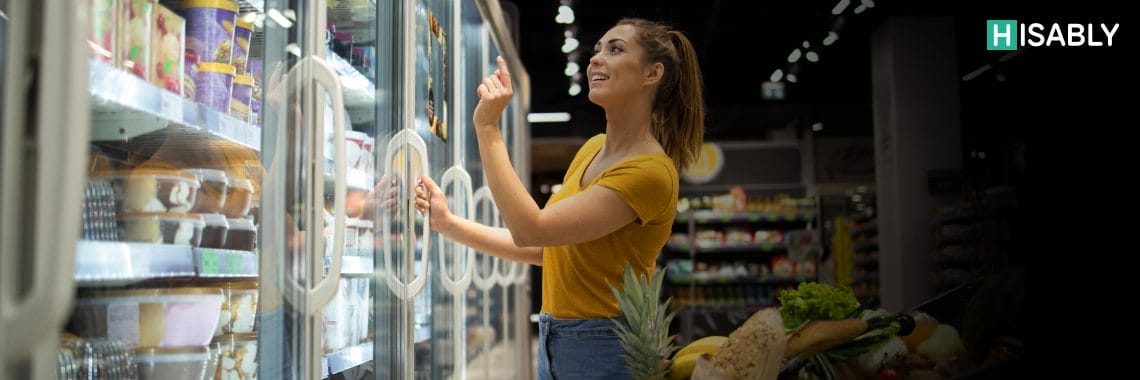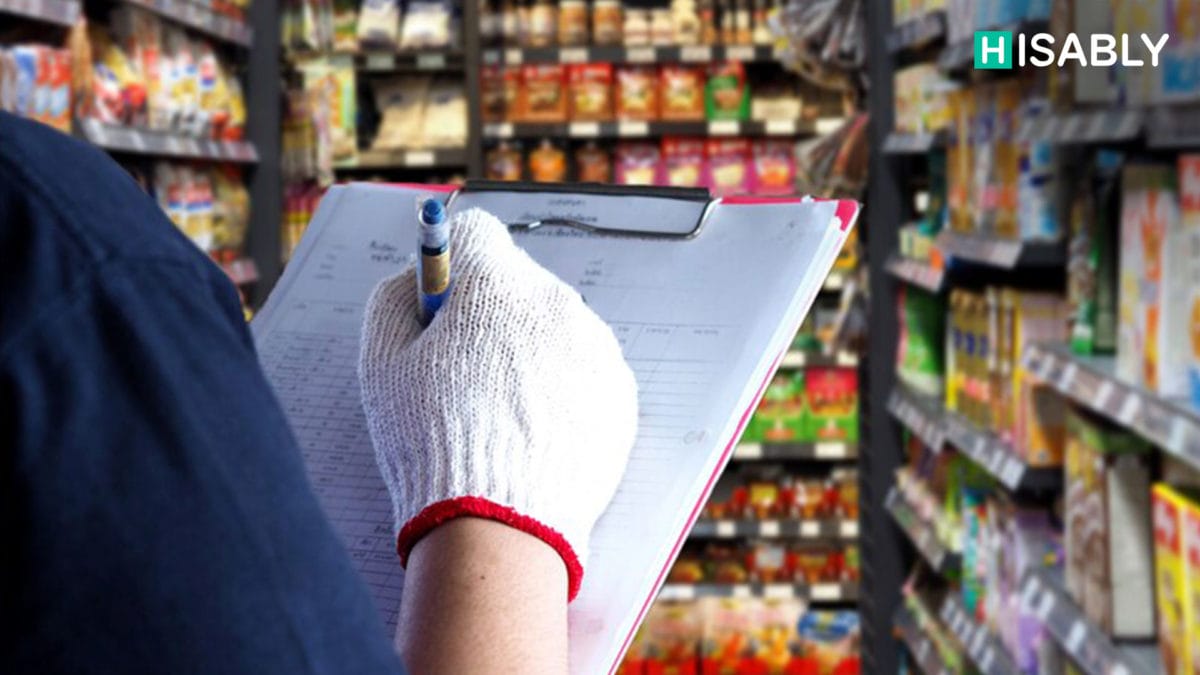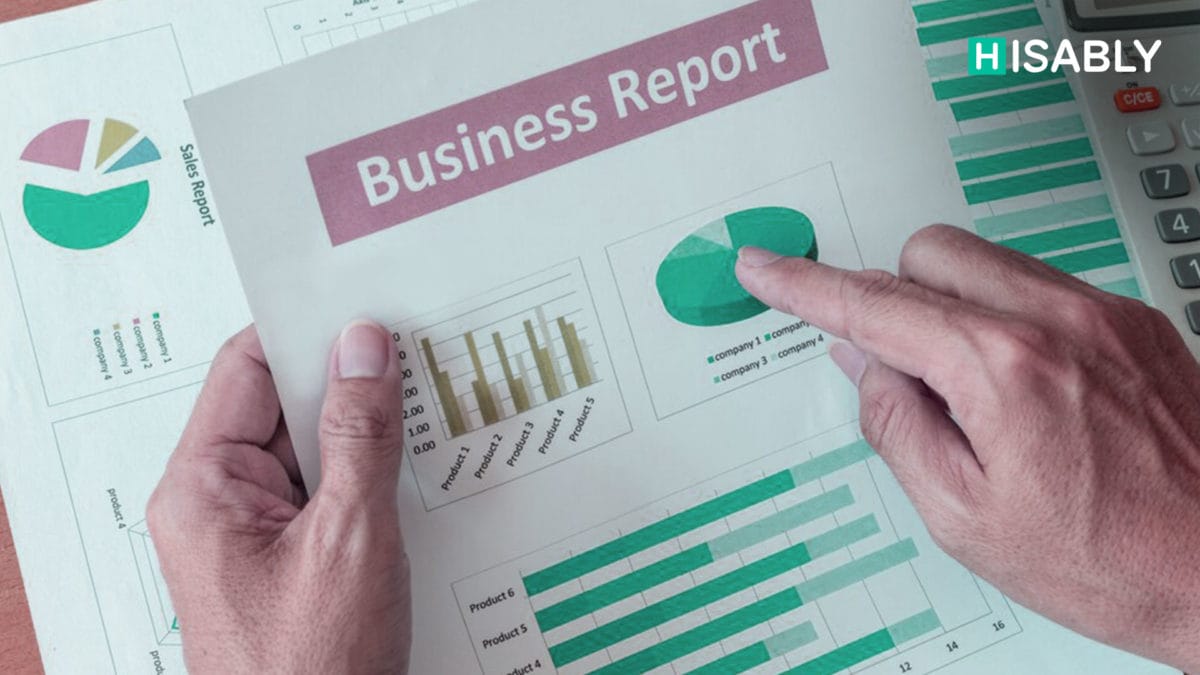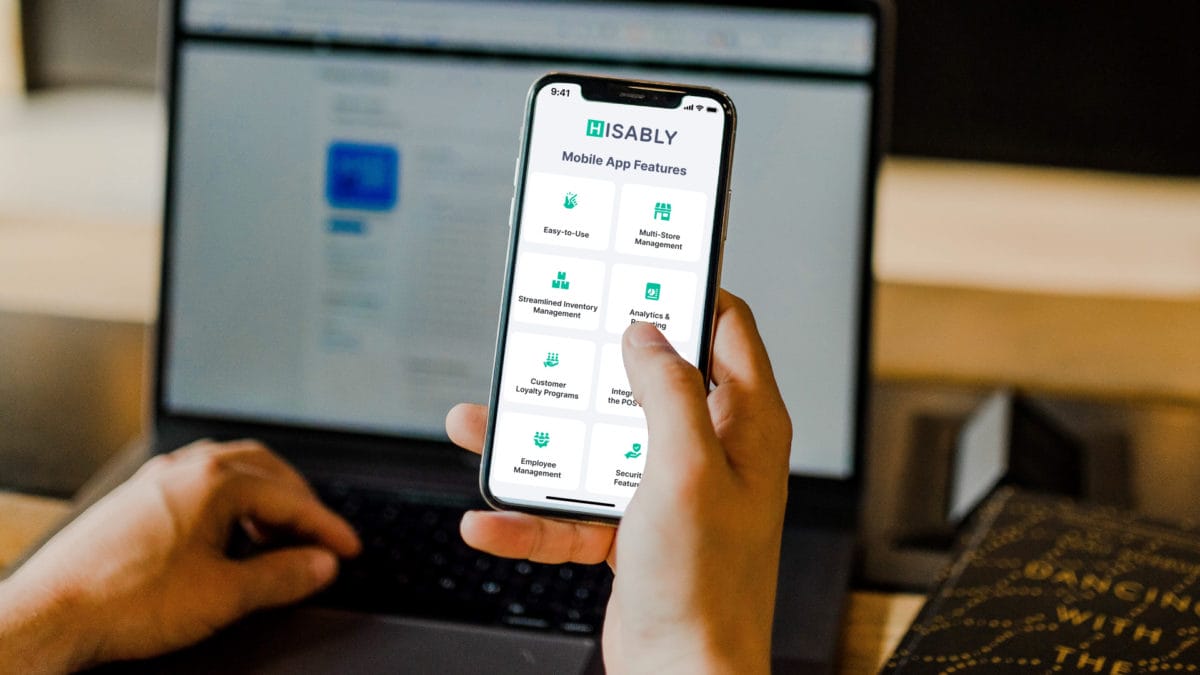Being a convenience store owner, you might struggle to manage multiple operations at a time, from inventory management to reporting and analytics. If you perform these operations manually, running the business successfully and efficiently is like a dream.
Hisably is the platform that ensures your dream comes true!
It’s an advanced back office and accounting solution designed to tackle the challenges convenience store managers face.
This blog post will discuss the most common hurdles in convenience store management and how Hisably effectively addresses them.
Whether you’re streamlining your inventory, optimizing financial management, or enhancing lottery management, Hisably is the ultimate platform for transforming how you manage your C-store.
Let’s examine the challenges faced by convenience stores and their solutions. Discover how Hisably can help take your store management to the next level.
Top 7 Challenges Faced by Convenience Store Owners and Its Solution
Tackling the complexities of convenience store management requires strategic insights and a robust solution. Here are the seven challenges store owners frequently encounter and how Hisably can optimize these pain points.
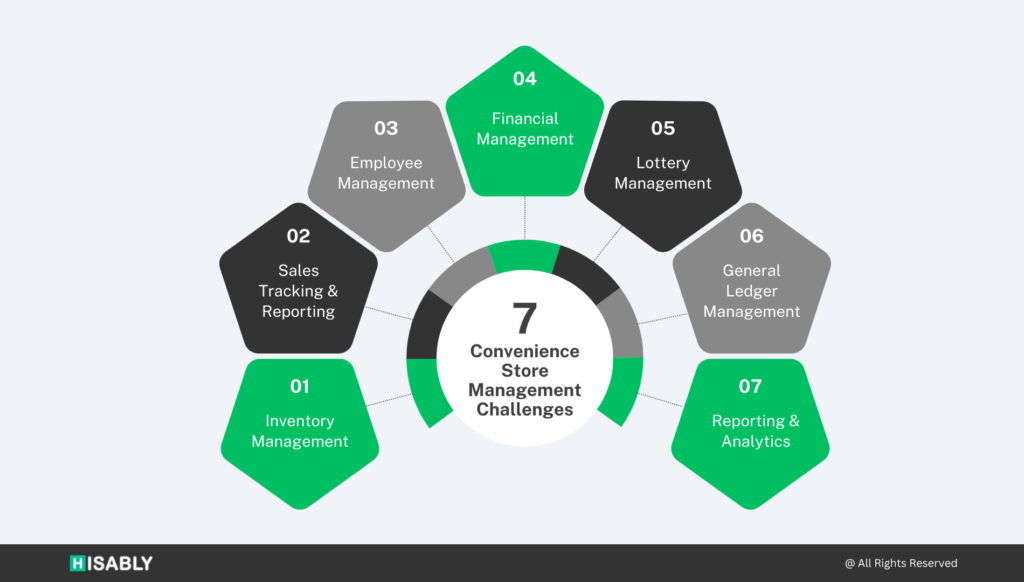
Challenge 1: Inventory Management

For C-store owners, effective management of inventory can be a complex challenge. It contains several specific issues that can significantly impact operational efficiency:
Overstocking and Understocking
Without precise tracking, stores often have too many of some items and not enough of others, leading to lost sales and wasted inventory.
Perishable Goods Management
Managing perishables is particularly challenging due to their limited shelf life. Inefficient management can result in considerable spoilage and financial loss.
Seasonal Demand Fluctuations
Failing to adjust inventory for seasonal peaks and troughs can leave a store either overwhelmed with excess stock or underprepared for a surge in customer demand.
Hisably Simplifies Inventory Tracking and Forecasting:
Hisably addresses these inventory challenges with robust features designed to streamline the entire process:
Automated Stock Level Notifications
Hisably’s system automatically monitors stock levels and alerts you when items are running low or are overstocked, helping you maintain the inventory balance.
Predictive Analytics for Perishable Goods
It analyzes sales trends to forecast the demand for perishable items, ensuring that you order what you need and reduce wastage.
Seasonal Trend Analysis
Leverage advanced analytics to identify seasonal trends, enabling you to prepare your inventory in advance for expected increases or decreases in product demand.
Optimize your inventory management with Hisably and be more responsive to your business and customers’ needs. It will help reduce losses and boost your store’s overall efficiency and customer satisfaction.
Challenge 2: Sales Tracking and Reporting
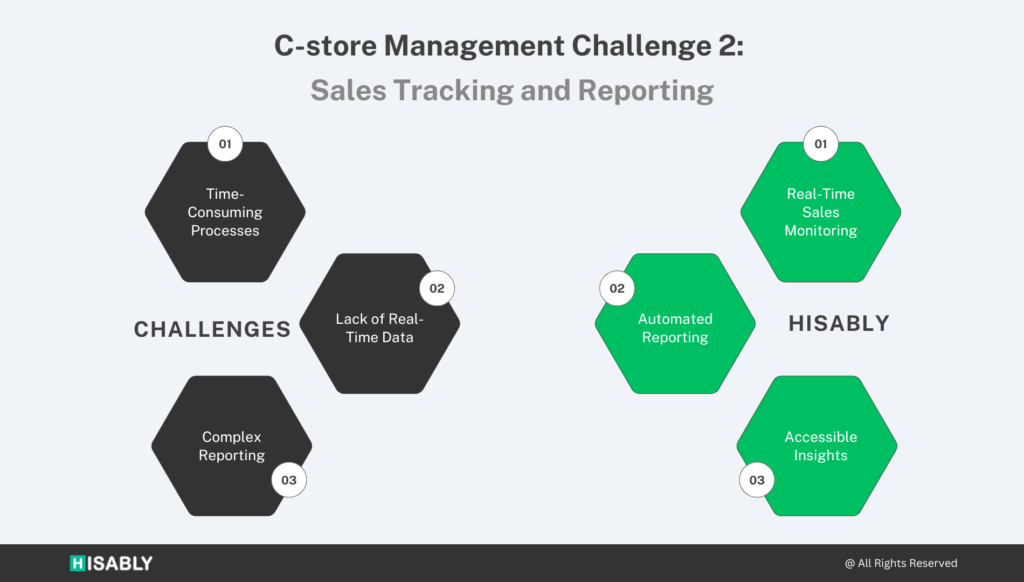
Keeping tabs on sales and generating accurate reports can be cumbersome, mainly when relying on manual methods. Here are some common issues faced by convenience store owners:
Time-Consuming Processes
Manual tracking is slow and prone to errors, leading to inaccurate sales data and financial discrepancies.
Lack of Real-Time Data
Without immediate access to sales data, making quick and informed decisions is challenging. Also, it becomes difficult to capitalize on trends or address issues.
Complex Reporting
Creating comprehensive reports manually is complex and often requires considerable effort and expertise, which can detract from other important business activities.
Hisably Enables C-stores with Real-Time Sales Tracking and Automated Reporting:
Hisably addresses these challenges by meeting the specific business needs of convenience stores:
Real-Time Sales Monitoring
Hisably offers real-time tracking features that provide up-to-the-minute sales data, allowing you to see what’s happening in your store anytime.
Automated Reporting
Sayonara to manual report generation process!
Hisably automates this process, delivering detailed sales reports at regular intervals or on demand, which helps in accurate financial planning and analysis.
Accessible Insights
With user-friendly dashboards and analytics, Hisably makes it easy to understand your sales trends, identify top-selling products, and assess overall business performance.
By embracing Hisably’s advanced sales tracking and reporting capabilities, convenience store owners can save time and gain valuable insights that drive smarter business decisions. This enhanced visibility into sales data helps manage the store effectively and paves the path for increased profitability and growth.
Challenge 3: Employee Management
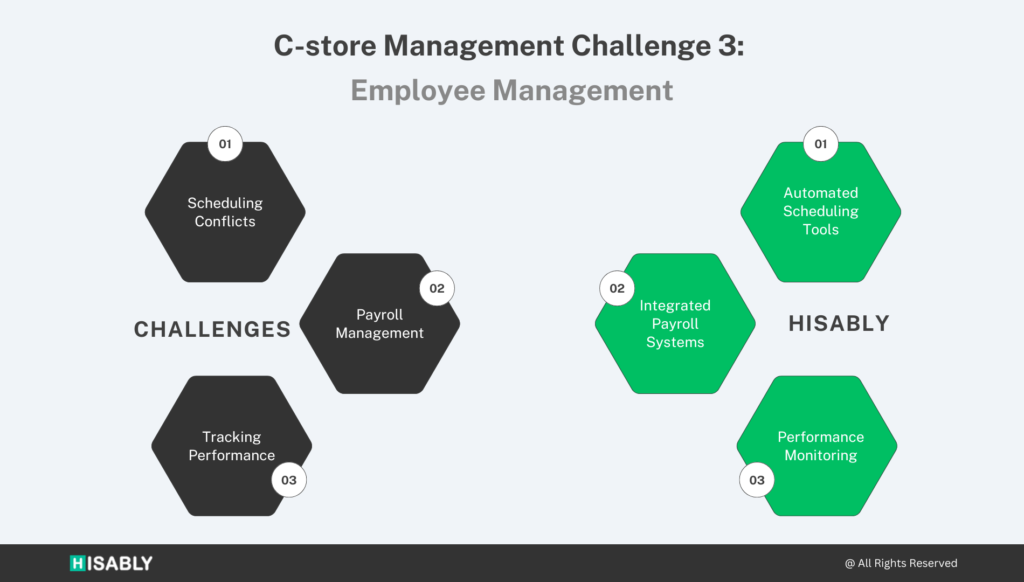
For employee management, convenience stores have a separate set of challenges to deal with, which involves
Scheduling Conflicts
Struggling employees’ availability with business needs often leads to scheduling conflicts, which can disrupt store operations.
Payroll Management
Handling payroll manually is time-consuming and fallible, which can lead to employee dissatisfaction.
Tracking Performance
Without a systematic approach, monitoring employee performance and providing timely feedback can be difficult, impacting overall store efficiency.
Hisably Streamlines Employee Management Processes:
Hisably optimizes each aspect of employee management, making it smoother and more efficient:
Automated Scheduling Tools
Hisably’s scheduling features allow for easy management of employee shifts, ensuring optimal staffing levels without the hassle of manual scheduling. Employees can also access their schedules remotely, reducing misunderstandings and conflicts.
Integrated Payroll Systems
With Hisably, payroll processes are automated and integrated directly with work hours logged in the system, ensuring accuracy and timeliness in employee payments. This automation reduces administrative burdens and enhances accuracy.
Performance Monitoring
Hisably tracks and analyzes employee performance, offering insights into areas where employees excel and where they might need additional training or support.
Integrating these functionalities into a single platform Hisably simplifies employee management and helps convenience store owners foster a more productive and engaged workforce.
Challenge 4: Financial Management
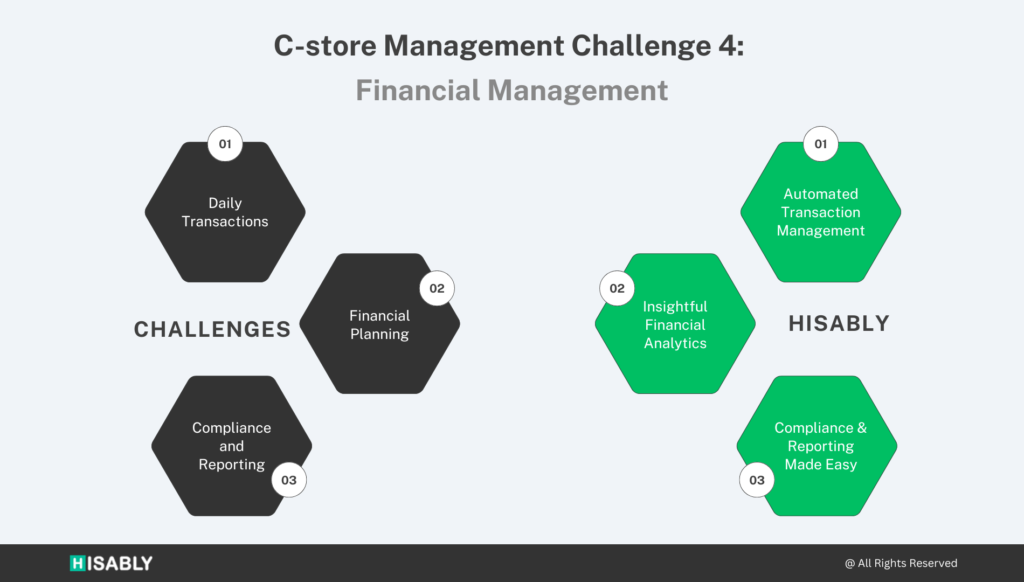
Navigating the financial waters of convenience store management involves more than just keeping the cash register ticking. Store owners face several financial management challenges:
Daily Transactions
Managing the influx of daily transactions can be overwhelming, especially when ensuring accuracy in entries and reconciliations.
Financial Planning
Without clear visibility into financial data, planning for future expenses or investments becomes a guessing game, which can hinder growth.
Compliance and Reporting
Staying on top of regulatory compliance and accurate financial reporting is crucial but can be cumbersome without the right tools.
Hisably Enhances Financial Management:
Hisably is a robust platform that tackles these financial hurdles and eliminates them by offering its advanced features:
Automated Transaction Management
Hisably automates the recording and reconciliation of daily transactions, reducing errors and freeing up your time to focus on other aspects of store management.
Insightful Financial Analytics
With Hisably’s comprehensive analytics, you gain a clear picture of your financial health, enabling informed decision-making about budgets, forecasts, and investments. This insight helps optimize financial planning and ensures that resources are allocated wisely.
Compliance and Reporting Made Easy
Hisably simplifies compliance and financial reporting by maintaining accurate records and generating reports that meet industry standards. This feature helps you stay compliant with financial regulations and prepares you for audits with less stress.
By integrating these financial management features, Hisably simplifies the complex financial operations of a convenience store and empowers owners with the data and tools necessary for successful long-term financial stewardship. It makes sure your store’s finances are as well-managed as your inventory.
Challenge 5: Lottery Management
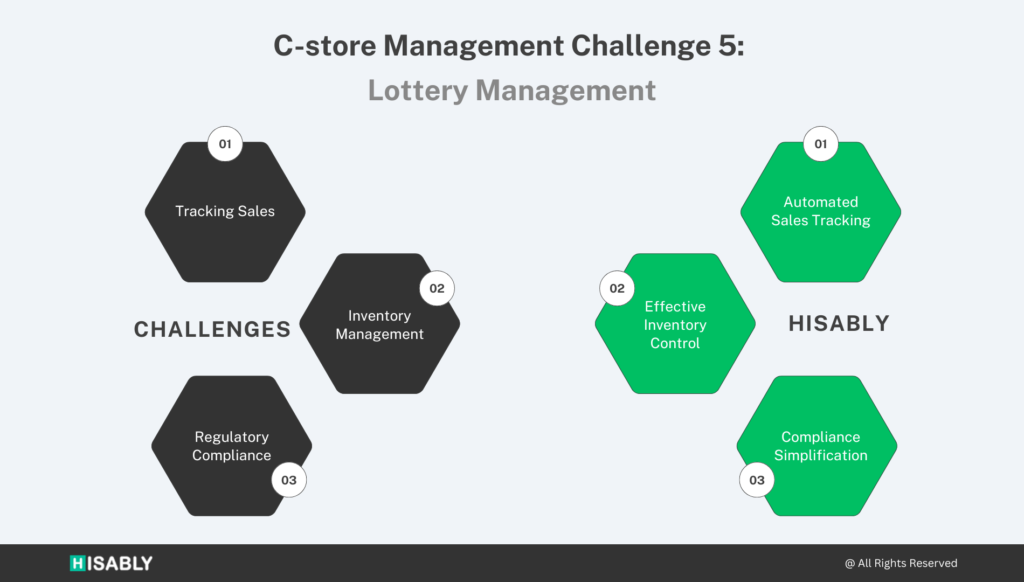
Managing lottery sales effectively is one of the biggest challenges for convenience stores:
Tracking Sales
Keeping accurate records of lottery ticket sales and payouts can be complex and time-consuming.
Inventory Management
Ensuring that all types of lottery tickets are adequately stocked and displayed can be challenging, particularly during high-demand periods.
Regulatory Compliance
Staying compliant with state and federal lottery regulations requires meticulous record-keeping and reporting.
Hisably Drives Accuracy in Lottery Management:
Hisably helps convenience stores streamline their lottery management:
Automated Sales Tracking
Hisably automates the tracking of all lottery transactions, ensuring accurate and up-to-date records of sales and payouts. It reduces errors and saves time that can be spent on other store operations.
Effective Inventory Control
Store owners can easily manage their lottery ticket inventory in Hisably. The system alerts you when stock is low, ensuring that popular tickets are always available to customers, thus maximizing sales opportunities.
Compliance Simplification
Hisably helps maintain compliance with lottery regulations through automated reporting features. It generates necessary reports for regulatory bodies, ensuring that your store meets all legal requirements without requiring manual paperwork.
With Hisably’s lottery management features, convenience store owners can ensure their lottery sales are as well-managed as the rest of their operations. By automating key aspects of lottery management, Hisably minimizes errors and enhances operational efficiency, making it easier to attract and retain lottery customers.
Challenge 6: General Ledger Management
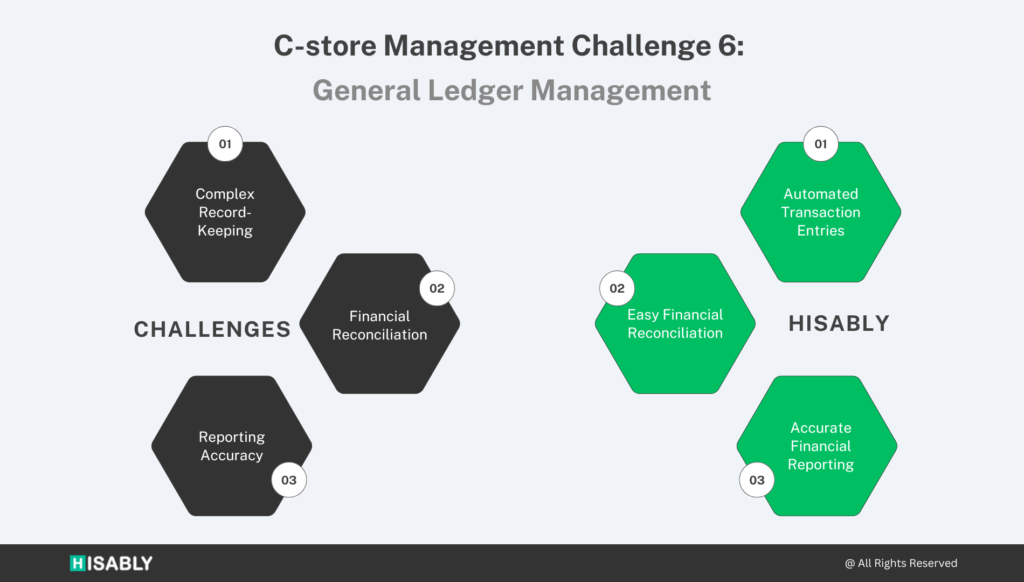
Maintaining an accurate and up-to-date general ledger is crucial for any convenience store, yet it poses several challenges:
Complex Record-Keeping
Managing the multitude of transactions that flow through a convenience store daily can make ledger management cumbersome and prone to errors.
Financial Reconciliation
Ensuring that all financial entries match up across different accounts requires constant vigilance and can be incredibly time-consuming.
Reporting Accuracy
Accurate financial reporting hinges on a well-maintained ledger. Any discrepancies can lead to serious compliance issues and skewed financial insights.
Hisably Simplifies General Ledger Management:
Hisably offers powerful solutions to streamline general ledger management for convenience stores:
Automated Transaction Entries
Hisably automates the entry of all transactions into the general ledger, ensuring accuracy and reducing the manual effort required. This automation helps prevent common errors associated with manual data entry.
Easy Financial Reconciliation
With Hisably, financial reconciliation becomes streamlined. The system automatically matches transactions across accounts, highlighting discrepancies for quick resolution. It saves time and ensures your financial data is always ready for analysis.
Accurate Financial Reporting
The solution provides detailed and accurate financial reports based on real-time data from your general ledger. These reports are essential for making informed business decisions and staying compliant with financial regulations.
By leveraging Hisably’s capabilities, convenience store owners can transform the daunting task of ledger management into a smooth, error-free process. It ensures financial accuracy and provides peace of mind, knowing your store’s financial health is always in check.
Challenge 7: Reporting & Analytics

For convenience store owners, the challenges of effective reporting and analytics can be significant hurdles to business growth:
Data Overload
Sifting through vast amounts of data to extract meaningful insights can be overwhelming, especially without specialized tools.
Lack of Real-Time Information
Making informed decisions requires up-to-date information, which can be hard to obtain if analytics aren’t real-time.
Complex Analysis Tools
Often, analytical tools can be too complex or technical for store owners without a background in data analysis, leading to underutilized data.
Hisably Provides Effective Solutions for Reporting & Analytics:
Hisably comes with built-in reporting and analytics capabilities that successfully address these challenges for the C-store owner.
Simplified Data Interpretation
The platform translates complex data sets into easy-to-understand reports and dashboards, making it simple for store owners to grasp key business metrics at a glance.
Real-Time Analytics
Offering real-time analytics, Hisably ensures you have the most current data at your fingertips, enabling timely and informed decision-making.
Customizable Reports
With Hisably, you can customize reports to focus on the information that matters most to your business, whether it’s daily sales, inventory levels, or employee performance. This flexibility allows you to tailor your analytics to meet your specific needs.
By leveraging Hisably’s reporting and analytics functionality, convenience store owners can overcome the traditional barriers to effective data use. It means having access to data and turning it into actionable insights helps C-stores drive business success and improve operational efficiency.
Wrapping Up
Effectively managing a convenience store requires overcoming various challenges. Hisably seamlessly addresses these issues, empowering store owners to operate more efficiently and profitably.
Don’t hesitate to contact us if you’re ready to take your convenience store management to the next level and want personalized advice on how Hisably can specifically help your business thrive.
Talk to our expert today and discover how our solutions can transform your store’s operations. Let us help you streamline your processes and boost your bottom line!








